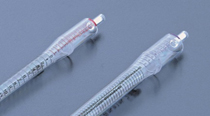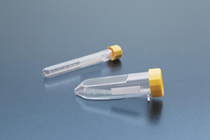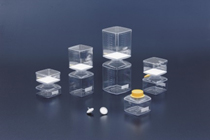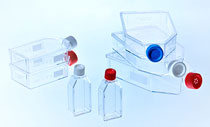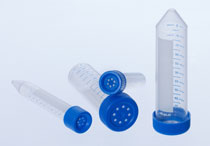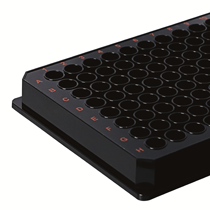Cell culture plastic ware in general
|
Plastic - who cares ? One might think so initially, but cell culture plastic ware may make a difference in your cell culture especially in your assays. Depending on the manufacturer, the starting material does not differ ( all cell culture flasks, dishes and multi-well plates to date are manufactured from polystyrene) but the surface modifications, the design, air flow, evaporation and other features may differ greatly. |
 |
Cell culture plastic ware surface modifications
The base material polystyrene without further treatment is not sufficient for cell adhesion in most cases. Therefore, all suppliers of cell culture plastic ware treat the surfaces of flasks, dishes and multi-well plates with ionized gas (corona-treatment) to produce surface modifications that make the surface more polar or charged. The mixture of plasma gases is secret and therefore, each supplier has a different surface modification.
The following surface modifications are used:
- positive charges
- negative charges
- positive and negative charges mixed
- polar groups
- additional hydrophobic modifications (for e.g. suspension cells)
|
Polystyrene
|
Surface modification
|
Classification Roughing Negative charges Positive charges Positive and negative charges Polar groups |
Depending on the quality and quality control of the plasma treatment, the surfaces may be activated for adhesion either homogeneously or artifacts may be introduced such as regions like edges are not treated or parts in the middle area are over or under-activated as shown in the images below.
| HeLa Zellen ca. 200x | HeLa Zellen ca. 200x |
 |
 |
Surface homogeneity compared in our lab course
In our practical course Cell culture bioassays, we test plates from different suppliers concerning evaporation and homogeneity. Thereby, the participants are able to judge for themselves how enormous the differences between manufacturers are. Some of the results of such tests, are shown below. However, you have to keep in mind that these are results of beginners. Mixing and pipetting errors partially contribute to the inhomogeneous distribution of cells. HEK cells were plated at a density of 30.000 cells per well (quite high), incubated over night and stained with crystal violet the following day. Cells are therefore, colored in blue to violett. The darker the color, the more cells are present in the respective well or area.The plates were not filled in the well-exterior space to reduce the edge effects (see below).
| Course result: Plate 1 | Course result: Plate 2 | Course result: Plate 3 |
|---|---|---|
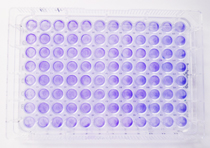 |
 |
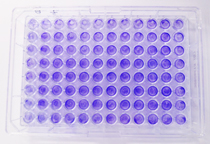 |
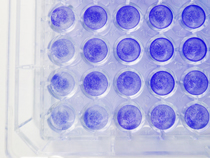 |
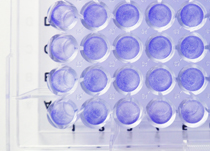 |
 |
Multiwell plates, air and gas flow, evaporation and edge effect
Another crucial point when choosing your cell culture consumable supplier is that the construction design of especially dishes and multi-well plates strongly influences the adhesion (general and areas), the distribution of cells and the evaporation from the plate or dish. In multi-well plates, this can prove problematic as the outer rows and columns usually give results totally different from the other wells and thereby increase the standard deviation of the results. This is nicely shown by the crystal violett stain shown in the images below. Equal cell numbers have been seeded in multi-well plates. 24h later, the cell cultures were fixed and stained with crystal violett. The darker the color, the more cells have adhered in the respective region.
| Combination of surface and edge effects | Combination of surface and edge effects |
 |
 |
When multi-well plates are kept in the incubator for more than 2 days, evaporation starts to become obvious visually. After 5 days however, the effects really become obvious and can be judged much more easily. The measured results of such an evaporation test is shown in the images below. There, the evaporation was quantitatively estimated and calculated as percent of the total volume. Looking at the high percentages and the patterns in some of the plates, it becomes absolutely clear how drastic the osmotic effects in the outer wells must be for the cells. The more liquid evaporates the higher the osmolarity (relative salt content) in the respective wells. Even though this might not be easily visible in short term assays, it is one reason that contributes to high standard deviations between wells.
| Edge effects displayed as evaporation: results from a bioassay course |
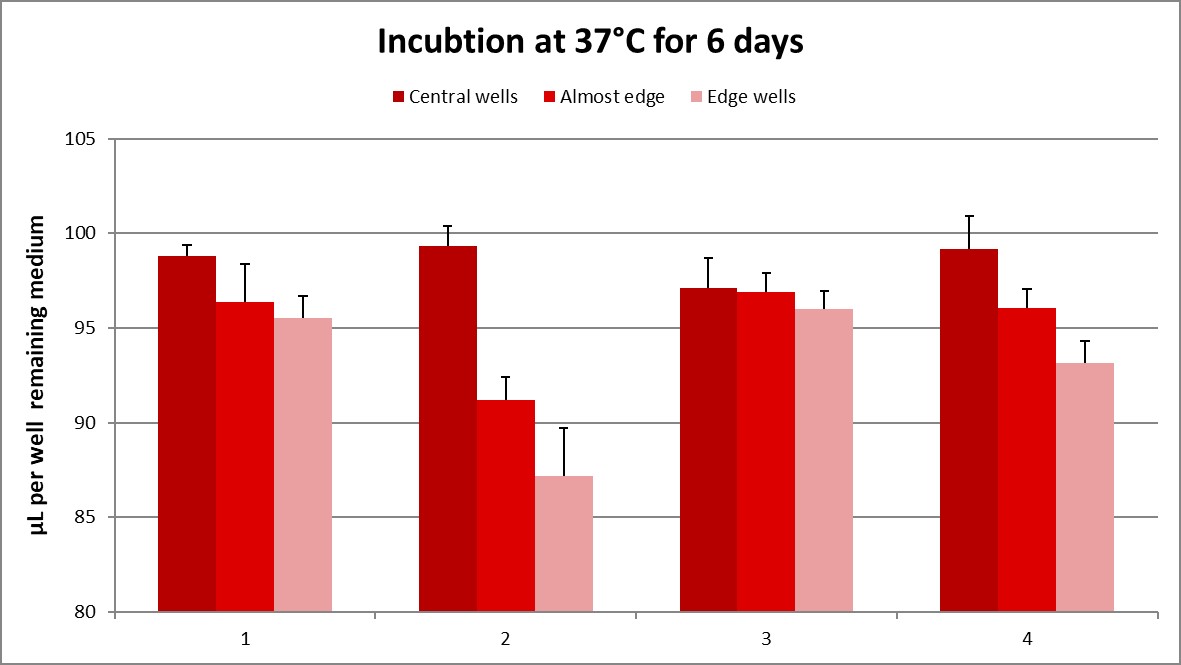 |
These effects are usually overcome by not using the outer wells. This however means that 30% of the plate are wasted. A second method is to use a foil-seal during the assay which blocks evaporation but also eliminates gas exchange which is not feasible for longer-term experiments. The last method is to use a humidity chamber into which the plate is placed. This often increases the risk of contamination. Eppendorf had designed its multi-well plates in such a way that two much smarter versions to overcome edge effects are possible. As shown in the below images, either an outer ring or the whole plate can be filled with liquid. This drastically reduces edge effects. Unfortunately, they stopped producing these plates. So right now, there is only the Nunc Edge plate that effectively stops the edge effect. Plates of other suppliers do not easily allow filling as the wells are interconnected and therefore, one would have to fill all spaces individually.
| Eppendorf multi-well with only the outer ring filled | Eppendorf multi-well with all interspace filled |
.jpg) |
 |
Further information on this topic is supplied by Nunc in an old Bulletin on this topic, at Wellplate more images can be found and a test was offered by Thermo Scientific.
Evaporation quick test (extreme challenge) in our lab course
In our practical course Cell culture bioassays, we test plates from different suppliers with respect to evaporation and homogeneity. Thereby, the participants are able to judge for themselves how enormous the differences between manufacturers are. Some of the results of such tests, are shown below. In this - due to the shortness of the course - drastically shortened quick experiment, evaporation was tested at high temperature in low humidity. The obviously best result was measured for the Eppendorf multi-plate (not available any more) with a filled outer anti-evaporation compartment. The other plates were not filled. Some plated are however, designed in such a way, that the filling is not possible. In a later course, the Nunc Edge plate gave results comparable or even better than Eppendorf.
| Course result: Plate 1 | Course result: Plate 2 | Course result: Plate 3 |
|---|---|---|
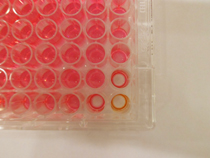 |
 |
 |
 |
 |
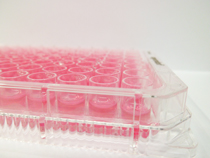 |
Microscopy and multi-well plates
Another factor that is often underestimated is the usability of multi-well plates for microscopical investigation. Often one doesn't even try any more, as especially in 96-well plates, the visuability is rather low. However, this is not true for all multi-well plates. Depending on the brand, the planarity (evenness) of the material and the type of plasma treatment strongly influences the optical results. The planarity defines how fast and how often we have to re-focus when we move the plates or dishes. In multi-wells, the plasma treatment defines whether the forming meniscus (liquid surface) is deep or shallow. The deeper the meniscus, the stronger is light diffraction and the harder it becomes to visualize cells. Two results of a test for microscopical usability are shown below. On the left-hand side you can see the meniscus in two types of plates (top: optimized plate with almost no meniscus, bottom: strong meniscus). On the right-hand side you see the resulting images from a phase contrast microscope.
| Meniscen in Multiwells | Mikroskopierbarkeit in 96-well Platten |
 |
 |
In our practical course Cell culture bioassays, we also test plates from different suppliers with respect to microscopic performance and visibility of cellular details as there are drastic differences between suppliers. The following images were taken during such a course. The top two rows show phase contrast images of HEK293 cells plated in 96well plates. The photos were taken in the center of the well at 400x magnification. The middle row always shows an enlarged section of the image above. The lower row shows HEK cells after crystal violett staining also at 400x. All images were taken using a Zeiss Axiovert and MRC5 camera. Here again, we clearly see that the optimized plate from Eppendorf (3) gives the best results, followed by TPP (2). The NUNC Edge plate also gave good results (not shown here).
| Course result: Plate 1 | Course result: Plate 2 | Course result: Plate 3 |
|---|---|---|
 |
 |
 |
 |
 |
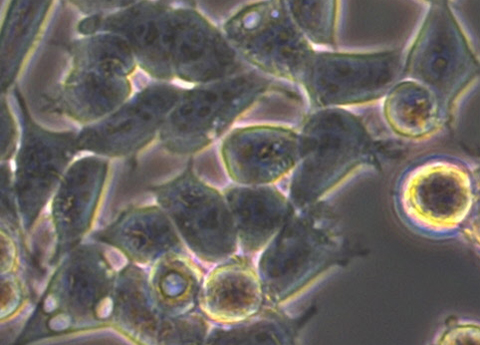 |
 |
 |
 |
Cell culture plastic ware supplier change
When changing the cell culture plastic ware supplier, you should always pay attention to how the cells react to the new surface. Sometimes, the cells only need some time to get used to the new surface (adaptation phase) but in other cases, the new plastic may allow the cells to grow faster or may make them a lot slower.
Cell culture plastic ware from different suppliers
|
In some labs, flasks and multi-well plates are purchased from different suppliers - usually for cost efficacy reasons. If this is done, one should keep in mind that the surfaces always differ between suppliers. Therefore, cells have to adapt to the new surface after plating. This may enhance the proliferation lag and may influence assay results. Therefore, it is highly favorable to use flasks, dishes, multilevel etc. from only one supplier. A second back-up supplier should be tested prospectively for situations where a change is needed. |
 |
Dishes, flasks, multiwell plates and disposable reactors for cell culture under GMP
|
For cell culture under GMP, the requirements and demands are higher. First, one should always have a back-up supplier (tested and documented) in case the normal supplier has difficulties supplying on time. In this case, it might cause large problems if assays do not run within the expected range of values because the "emergency replacement" plastic affects cell growth. In order to circumvent this, several suppliers should be initially tested and the "suitable" back-up should be defined and documented. Second, if cells or tissues are cultivated in order to be used as ATMPs (advanced therapy medicinal product) or TEP (tissue engineering product) it is additionally, necessary to check the plastic ware supplier files for tests on leachables and extractables, USP quality of materials, biocompatibility and pyrogen testing, as well as SAL levels. |
 |
Plastic may contain certain chemicals that are used in the process of production or convey certain attributes to the plastic (e.g. release aid or softeners). These may leak out or may be extracted from the plastic during the culture period. Then, cells or tissues may take up these compounds and eventually they are transplanted with the ATMP / TEP into the patient. Within the patient, the compounds may exert unwanted side-effects or they may elicit inflammatory reactions. Due to this there are regulations and testes for such plastic. Good suppliers work with high quality polystyrene without and additions and do provide certificates on leachable and extractable testing (e.g. USP class 6 conformity).
Cell culture plastic ware suppliers
There are numerous suppliers of cell culture plastic ware. Note: the most expensive cell culture plastic ware does not always have to be the best choice for your cells. A plastic ware check is always worth being performed with primary cells as these are more choosy. For cell lines on the other hand, you may start with the brand presently used in your lab and you only test if you have problems or in order to find a back-up supplier.
For cell culture under GMP it might be advisable to choose a supplier that produces in western Europe or the US as the quality standards are usually more reliable in these countries.
Short-list supplier comparison
As a basis for comparison of list prices, the last column states the non-binding last list price quota we got for 1 T75 cell culture flask in the smallest available packaging unit. Specifications were: surface for adherent cells, angled neck and vented lid with filter. (Last up-date 2012-04).
| BD | Life Science Products. Page is not really straight-forward and even after registration no prices are online. Try a distributor like Thermo or VWR cell culture, Prices online. | 1,45 to 1,92 Euro via VWR |
| Brand | Cell culture multi-well plates and inserts for Co-culture. | n.a. |
| Corning | Country selection page. The page is circuitously built, prices online in US$. Prices in Euro may be found via Omnilab Shop. Search function is not always easy but prices in Euro online. | 1,68 bis 2,45 Euro depending on the flask type |
| Eppendorf AG | Eppendorf has stopped producing cell culture consumables. Still available are the 5 mL, 25 mL and now 50 mL centrifugation tubes. | na |
| Faust Lab Science GmbH (TPP and others) | Is the german distributer of TTP products such as flasks, multi-well plates, dishes, tubes etc. Other distributors are listet on the TPP website. | 1,06 Euro |
| Greiner Bio-one | Products, Prices online available but only after registration. | 1,25 to 3,35 Euro depending on the surface |
| Nunc (Thermo Scientific) | Cell culture products, Sales only via Thermo or distributors such as VWR VWR cell culture products, prices online. | 1,74 via Faust, 1,84 Euro via VWR |
| Porvair Sciences | Cell culture products, prices online. | 0,88 Euro |
| Sarstedt | Hauptseite. Detailed information in PDFs, prices via phone even without registration. | 0,84 to 1,06 Euro depending on the surface |
| TPP | All products are listed on TPP website. Also international distributors are listed here. | 1,06 Euro |
| VWR | Distributes several brands e.g. BD, Nunc via VWR cell culture, prices online. | 1,45 to 1,92 depending on brand. |
TPP (über Faust Lab Science in Deutschland)
| Productio site | Products are made in Switzerland |
|
| QA |
QA-system certified according to EN ISO 9001:2015. Voluntary dedication to cGMP guidelines. |
|
| Raw materials |
PS: Highest grade, virgin raw material
PP: Highest grade, virgin raw material
PE: Highest grade, virgin raw material
Cytotoxicity: Non-cytotoxic, proven by representative tests according to ISO 10993-5:1999, USP chapter 87.
RNA/DNA / RNAse/DNAse: Free of detectable RNA/DNA, RNAse/DNAse and ATP.
Endotoxin: Free of detectable endotoxin (pyrogenes).
Pipettes: Not haemolytic.
Sterility: TPP products are solely shipped sterile. Sterilizing process validated according to ISO 11137-1:2006. SAL 10^3 for regular and 10^6 for B3 products. Quality certificates: Quality certificates can be generated by entering product number and lot number at: www.tpp.ch. |
|
| Products |
Tissue culture flasks 25 – 300 cm^2 Tissue culture flask 115 – 150 cm^2 with re-closeable lid Tissue culture flask 25 -300 cm^2 with peel-off foil Tissue culture multi-well plates / test plate 6 – 96 wells Tissue culture dish 40 – 160 cm^2 TubeSpin Bioreactor 15 – 600 ml, TubeSpin Bioreactor 50 with Septum, Shaking plate for TubeSpin Bioreactor 600 PCV-packed cell volume tube and easy read“ measuring device Tissue culture flat tubes 10 cm^2 for low cell numbers Tissue culture tube 20 cm2 Clipmax flask with 10 cm^2 glass slide bottom for microscopy Cryo tubes 1.22 – 5 ml Serological pipettes with reservoir 25 – 70 ml Turbo-Fix Pipettor Centrifuge tubes 13 – 50 ml Cell spatula and cell scraperRacks for cell culture centrifuge tubes Boxes Vacuum filtration „rapid“-Filtermax 150 – 1000 ml Syringe filter 0.22 µm – 0.45 µm |
|
| Surfaces |
Surface-activated growth area for optimal adhesion and best proliferation of adherent cells. Optimal surface treatment includes:
|
|
| Coated vessels | No coating with proteins. | |
| Special products |
Clipmax: special microscopy slide with mounted culture flask. Suitable for stainings and immunofluorescence. Resistant to solvents. Flat cell culture tubes for low cell numbers. |
|
| Price | Low to medium. | |
| Cells |
Special extended test on cell lines have not been performed. However, regular quality tests with L929 mouse fibroblasts show optimal results. Application notes downloadable at TPP or the local distributor. |
|
| Known advantages |
Special products:
Quality certificates can be generated and printed without registration by entering a product and specific lot number on www.tpp.ch. cGMP: TPP voluntarily keeps compliance with cGMP guidelines. |
|
| Known disadvantages | No protein-coated cell culture vessels offered. | |
| Further information | Flyer, brochures and application notes are listed on the individual product pages on the lower right side. Examples are Clipmax, flasks with peel-off foil, resealable flasks, bioreactor, bioreactor with septum, cell culture-tubes, disassemblable rack. | |
| Website |
TPP direct or internationally distributors such as Faust Lab Science GmbH in Germany TTP-products. |
Greiner Bio-one
| Production sites | Germany (flasks), Hungary (dishes) as well as Austria, UK, Thailand, Brazil, US |
|
| QMS | QA system certified according to DIN EN ISO9001:2008 and partially DIN EN ISO13485:2012 (e.g. cyro tubes) | |
| Raw materials | PS: USP class 6 | |
| Products |
CELLSTAR® cell culture flasks, dishes, tubes, multi-well and micro-well plates, CELLCOAT® protein-coated cell culture vessels, CELLview™ dishes for live cell imaging, CELLview™slides for microscopy, Cryo.s™ Cryo-tubes with CE/IVD certificate for cryo- and bio-banking, ThinCert™ cell culture chambers for co-culture or migration and transport studies, EASYstrainer™ cell sieves (= cell strainer), CELLreactorTM, Serological pipettes, roller bottles, cell scraper. |
|
| Surfaces | Mostly negative charge: carboxy and hydroxy groups and for Advanced TCTM products a "polymer modification not further described". | |
| Coated plastic ware | Poly-L-Lysin, Poly-D-Lysin, Collagen Type I, Fibronectin, Laminin. Coating proteins at the moment all of animal origin. | |
| Price range | Middle to high for special TC surfaces. | |
| Known advantages |
|
|
| Known disadvantages | In order to get price information you have to register and wait for the access mail. | |
| Additional information | Greiner Publication on Advanced TCTM Products. | |
| Web site | Products |
BRAND
| Production sites | Germany without exception. |
|
| QMS, Certificates |
QA system certified according to DIN EN ISO9001:2015
|
|
| Raw materials |
|
|
| Products |
|
|
| Surfaces |
Plasma treated modification of cell culture plastics
|
|
| Coated plastic ware | Only anti-attachment surfaces: inertGradeTM: hydrogel coated. Prevents cell adhesion. | |
| Price range | Approximately 120 €/ pack (50 plates incl. lids, single wrapped) | |
| Cells |
Multiwell plates and inserts have been tested using:
|
|
| Known advantages |
|
|
| Known disadvantages | Portfolio lacks standard 48-, 24-,12- and 6-well plates | |
| Additional information | Application notes: https://www.brand.de/service-support/downloads/category/technote | |
| Web site | www.brand.de |
Eppendorf
Unfortunately, Eppendorf has stopped the production of their cell culture consumables like flasks, plates, multiwell and dishes. The 5 mL Eppi is still available.












